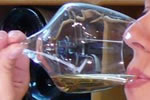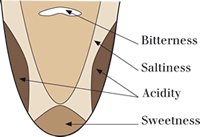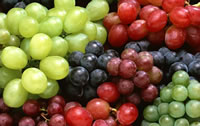Wine-tasting is the art of appreciating a wine with 3 of our five senses: sight, smell and taste.
It is an art which requires practice and concentration. Anyone can become a good winetaster!
In this edition, we develop the third sense: the taste! |
 |
 |
Once we take the first sip, millions of taste buds situated in our mouth, especially on our tongue, allow us to perceive the 4 primary tastes: sweetness, saltiness, acidity and bitterness. |
The taster gives a short description of the different stages:
- The attack: The first impression, when we usually feel the sweetness of the wine
- The evolution: The way the wine develops on the middle palate so that we can feel the acidity and the astringency
- The aftertaste: Last perceived aromas, e.g. we can find that a wine is sweet
- The length: Aromatic persistency, e.g. a wine can have a short, medium or long finish
- The balance or harmony: A good wine always has a good balance. A red wine needs to have a good balance between sweetness, acidity and tannins. A white wine needs to have a good balance between sweetness and acidity.
Some additional vocabulary used to describe the taste:
 Astringent: Sensation of dryness, perceived mainly on gum tissues inside cheeks and often associated to a slight bitterness, indicating the presence of tannins (present in the skins, seeds and/or oak barrels) Astringent: Sensation of dryness, perceived mainly on gum tissues inside cheeks and often associated to a slight bitterness, indicating the presence of tannins (present in the skins, seeds and/or oak barrels) - Soft: Very round, supple, low in acidity
- Fleshy: A round, richly flavoured taste
- Body: The impression of the weight of the wine in the mouth due to a combination of alcohol and other flavor components. Warm climate wines, due to the increased ripeness of the grapes, have greater weight and to have more body
- Complex: When each sip brings another flavor, reveals another nuance (opposite to simple).
- Earthy: An impression of damp soil, a dry garden just after a rain. This category also includes spicy, mineral and vegetal smells and tastes. This is a positive attribute and the reflection of a particular terroir.
- Firm: A wine that has a well-defined tannin or acid structure
- Fresh: A wine that is youthful and lively, often with some acidity.
- Light: Lacking in body but not unpleasant.
- Lively: A wine with refreshing acidity.
- Round: A smooth wine, with no hard edges. To describe the same quality we also use: satin, silk, velvet.
In the next issue of Assemblage we will give some recommendations on food and wine pairing!
|



